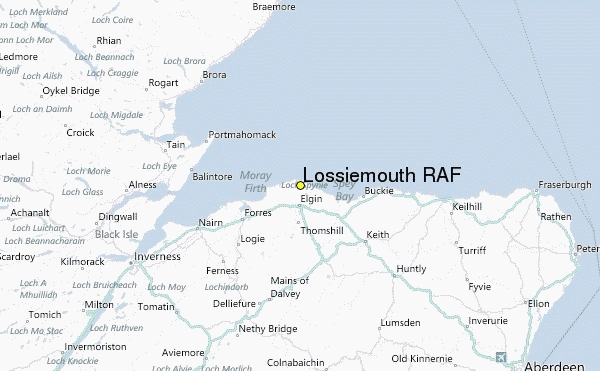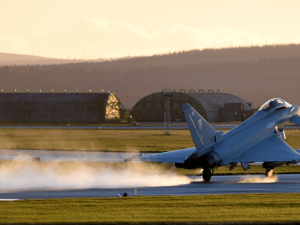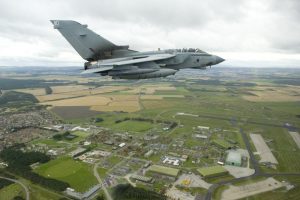2016-11-08 By Robbin Laird
In April and June 2016, I had a chance to visit RAF Lossiemouth in Scotland and to talk with the base commander, and several officers involved with the combat operations and logistical support for the aircraft operating from the base.
As such, the interviews provide a slice of current activities and preparation for the transition associated with the evolution of the RAF combat aircraft, including the coming of the P-8.
According to the RAF Lossiemouth website:
RAF Lossiemouth has entered another significant period of its history. The Station remains an important fast jet main operating base within the Royal Air Force, with both Tornado and Typhoon squadrons based here.
RAF Lossiemouth remains the home to the Tornado GR4 Operational Conversion Unit, XV (Reserve) Squadron, who train all Pilots and Weapons Systems Operators to operate the Tornado GR4.
During the summer of 2014 two Typhoon squadrons, 6 Squadron and 1 (Fighter) Squadron, relocated to RAF Lossiemouth. The Station’s third Typhoon squadron, II(Army Co-operation) Squadron relocated from RAF Marham in early 2015.

As part of the changes, the Station assumed Quick Reaction Alert (Interceptor) North (QRA(I)N) duties from September 2014. RAF Lossiemouth is now primarily responsible for maintaining QRA(I)N – providing crews and aircraft at high states of readiness 24 hours a day, 365 days a year, to police UK airspace and to intercept unidentified aircraft.
Additional units at RAF Lossiemouth include No 5 Force Protection Wing of the RAF Regiment. 5 Force Protection Wing includes a regular field squadron, 51 Squadron RAF Regiment, and a reserve squadron, 2622 Squadron of the Royal Auxiliary Air Force Regiment.
RAF Lossiemouth currently is a Typhoon and Tornado base, but with the Tornados to be phased out within the next few years, the Typhoons will be joined by the P-8, which will operate as well from Lossie.
This provides the opportunity to integrate the Typhoons with P-8s with the F-35s, which will initially operate off shore from the new carriers or, in other words, shaping a offensive and defensive enterprise to protect the homeland and to anchor the defense of the Northern NATO countries.
In effect, Lossie will train to support the formation and evolution of a 21st century combat force in which a multi-mission combat fleet of Typhoons will work with the maritime-focused but land-based capable maritime combat system which is the P-8 (which will be based at RAF Lossiemouth), and which, in turn, will work with the multi-tasking flying combat system which is the F-35 which will be based at RAF Marham.

It is clear that the base is well positioned to support the evolving dynamics of defense, not only for the UK homeland, but to provide a solid anchor within the defense system for the North Atlantic.
In this series, the 10 interviews will be published in turn and then a Special Report drawing together the various interviews with an overview published at the end of the series.
In that Special Report, the transitions at RAF Waddington and RAF Marham will be discussed as well with regard to the changing infrastructure to support 21st Century air operations from the United Kingdom.
We will include as well a discussion of RAF Lakenheath, and a look at how the USAF transition can provide for enhanced synergy with the US and other allied air forces transitions as well.

We will start with the first interview with Group Captain Paul Godfrey, the base commander with regard to his perspective concerning the evolution of the base in preparing for the RAF airpower transition.
We will then present interviews, which look at the coming retirement of the Tornado, its legacy and its contribution to the transition as well.
We will then look at the Typhoon and its key role for the RAF, in Quick Reaction Alerts, Operation Shader and in the Baltic Air Patrol.
Insights are provided by interviews with the 1 (F) Squadron, 2 (AC) Squadron, and those charged with the responsibility of maintaining and supporting the Typhoon fleet at Lossie and in its expeditionary operations, which include deployments to the Falklands as well.
We will then publish an interview with an officer involved in keeping the skill sets alive while waiting for the P-8, which highlights how the RAF is handling a very difficult transition, namely. the retirement of the Nimrod PRIOR to receiving a replacement aircraft,.
We will then close the series from RAF Lossiemouth with the second interview with Group Captain Paul Godfrey, who will highlight the challenges and opportunities of shaping RAF transformation as seen from a key operating base for the RAF.

